Snapshots: Compensation for Workers with and without Access to Health Benefits at Work
A newer version of this Snapshot is available here.
Compensation for Workers with and without Access to Health Benefits at Work
October 2008
This paper compares the payroll and benefit compensation of workers that had access to employer-sponsored health benefits at work to that of workers who did not have an insurance offer. By analyzing compensation differences within occupations and establishment sizes for those with and without access to health benefits, we provide new information to help policymakers as they consider how to design effective and targeted strategies to increase job-based coverage.
Surveys of employers indicate that smaller and lower wage firms are less likely to offer health benefits to workers, but do not provide detailed information about wage and benefit differences for workers with and without an offer of health benefits working in different settings.1 In this Snapshot, we use information from a nationally representative survey of workers to provide a fuller picture of the compensation for workers with health coverage access at their job compared to those without such access by firm size and occupation. We also look at trends over time.
Our analysis is based on data from the National Compensation Survey (NCS), which is a nationwide survey of labor costs in private and public establishments conducted quarterly by the Bureau of Labor Statistics (BLS).2 Details about the NCS and our analysis are available in a methodological appendix at the end of this analysis. Worker compensation is divided into three categories: payroll costs, fringe benefit costs excluding employer payments for health insurance, and employer payments for health insurance. Differences in compensation between workers with and without access to health benefits are compared with regard to payroll and non-health fringe benefits.
Definitions of key terms:
- Payroll costs include employer payments for wages, salary, overtime, vacation, holiday, sick days, bonus, and other cash compensation to employees, but exclude severance payments and unemployment benefits.
- Employer costs for health benefits include all employer payments for health coverage and exclude employee contributions to premiums or out-of-pocket medical cost-sharing.
- Non-health fringe benefits include employer payments for life and short-term disability insurance, defined benefit and defined contribution pension plans, worker’s compensation, and Social Security and Medicare payroll taxes.
- Total compensation is defined as the sum of payroll and all fringe benefit costs including health.
- Establishment size is the number of employees at a selected plant or office. Firms may be made up of one or more establishments.
Compensation Levels
Employees with relatively high wages are more likely to have access to employer-provided health benefits. Employees in establishments with access to health benefits, on average, receive more than twice as much in payroll and non-health benefit compensation as employees who do not have access to health benefits at work (Figure 1). When employer costs for health benefits are added to compensation for workers who have access (i.e., total compensation), the difference between these groups grows. In 2005, employees with access to health benefits had total compensation averaging $30.01 per hour, compared with $12.43 for employees without access. The gap has been widening. From 1999 to 2005, the real percentage change in total compensation for workers with access was about 9.8 percent compared to 2.8 percent for those without access.3
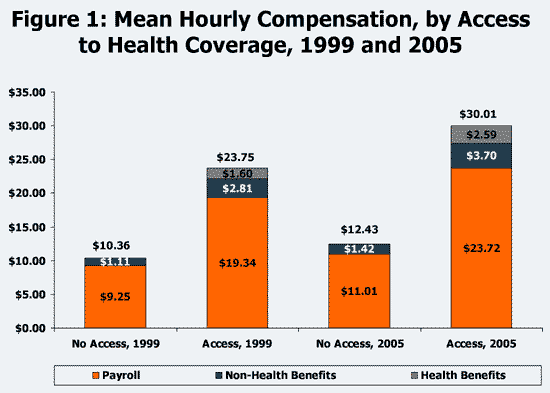
Source: Kaiser Family Foundation calculations based on data from the National Compensation Survey, 1999 & 2005, conducted by the Bureau of Labor Statistics.
Workers with access to health benefits are disproportionately in higher paid occupations, although we still find significant differences in average payroll compensation within occupation categories for workers with and without access (Figure 2). (We focus on payroll compensation for the remainder of this section because it is by far the largest portion of total compensation). Large differences in average hourly payroll compensation were found for workers with and without access to health benefits in nine of ten selected occupation categories, with a range of average hourly payroll costs, in 2005 (Figure 2). Some of the most notable differences occurred in the more highly paid professional and executive management occupation categories.
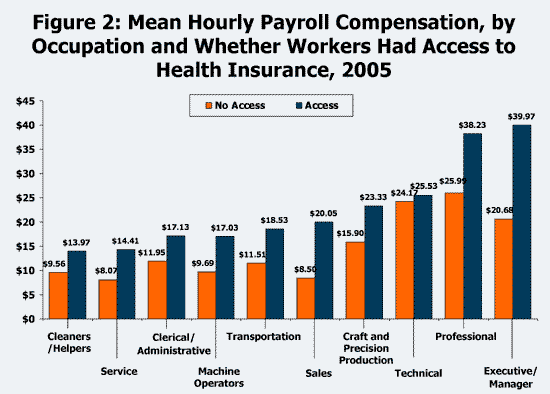
Source: Kaiser Family Foundation calculations based on data from the National Compensation Survey, 2005, conducted by the Bureau of Labor Statistics.
Because a wide variety of jobs can be captured even within a single occupation category, particularly for occupations like the sales, professional, and executive/manager categories, we assessed how payroll compensation is distributed within occupation categories. Figures 3 and 4 show the 25th percentile, median (or midpoint), and 75th percentile of payroll for workers with and without access to health benefits within each of the ten occupation categories in 2005.4 For example, looking at workers with access to health benefits in the service occupation, 25 percent had payroll compensation at or below $9.34, one half had payroll compensation equal to or less than $12.10, and 75 percent had payroll compensation at or below $16.50. In contrast, for service workers without access to health benefits at work, a quarter had hourly payroll compensation at or below $6.21, one half had hourly payroll compensation at or below $7.28 and only one quarter had hourly payroll compensation above $8.91. This is a lower and narrower range than is seen for service workers with access to health benefits. Large shares of workers without access to health benefits have relatively low payroll compensation when compared to workers within the same occupations with access to health benefits. In fact, for several of these occupations, the payroll compensation at the 25th percentile for those with access was greater than the 75th percentile for those without access.
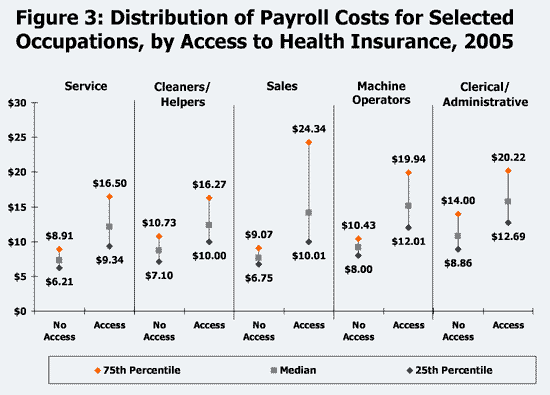
Source: Kaiser Family Foundation calculations based on data from the National Compensation Survey, 2005, conducted by the Bureau of Labor Statistics.
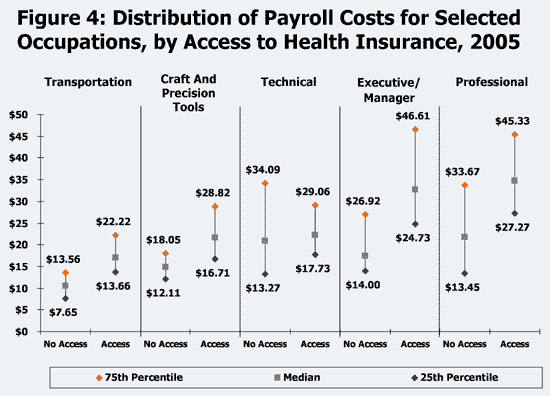
Source: Kaiser Family Foundation calculations based on data from the National Compensation Survey, 2005, conducted by the Bureau of Labor Statistics.
A similar pattern emerges when payroll compensation for workers with and without health benefit access is examined by the size of the establishments where they work. Average payroll compensation is much higher for workers with health insurance access than for workers without access across all establishment sizes (Figure 5). The distributions for payroll compensation for workers with and without access by establishment size confirms that most workers with access have much higher payroll compensation than the majority of workers without access (Figure 6). For workers without access to employer health insurance, there is a noticeably lower and smaller variation in payroll compensation. In five out of the seven establishment size categories analyzed here, the 25th percentile of payroll for workers with access exceeded the 75th percentile of payroll for workers without access.5
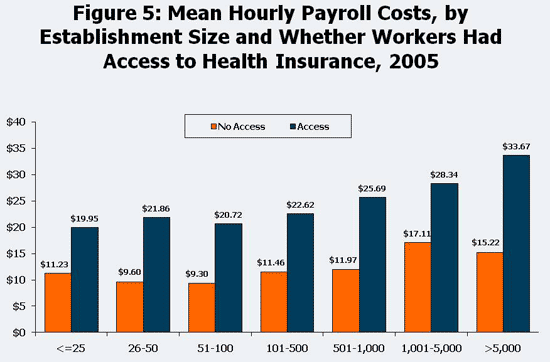
Source: Kaiser Family Foundation calculations based on data from the National Compensation Survey, 2005, conducted by the Bureau of Labor Statistics.
These data were corrected on 10/4/2010.
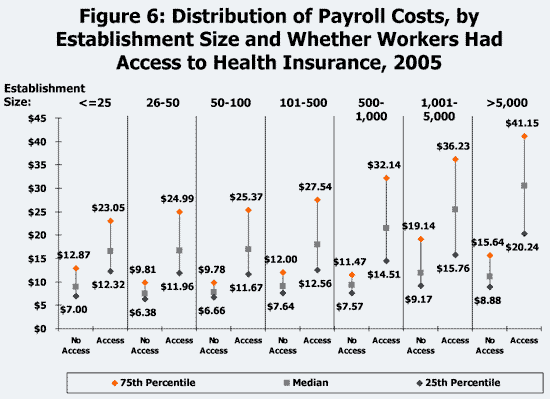
Source: Kaiser Family Foundation calculations based on data from the National Compensation Survey, 2005, conducted by the Bureau of Labor Statistics.
Changes in Compensation
Health benefit costs grew rapidly from 1999 to 2005,6 so we might expect, all other things being equal, payroll and non-health benefit compensation to have grown more slowly for those with access to health benefits than for those without access. Since workers with health benefit access saw a greater share of their compensation shifted to health benefits over the period,7 in theory, this relative growth in the health benefit costs should be offset by a reduction in the growth of payroll and non-health benefits. On the other hand, the compensation of workers without health insurance access is not directly affected by the rapid rise in health benefit costs, so changes in their total compensation should rise with other factors, such as their overall productivity.
However, payroll and non-health benefit compensation did not rise more over this period for workers without access to health insurance than it did for workers with access; in fact, workers with access to health benefits appeared to have slightly higher compensation increases over the period (Figures 7 and 8). A possible explanation is that the period of time that we observed is too short for wages to adjust to the growth in health benefit costs, and that we would see the expected pattern if a longer period of time were available. Another possibility is that average productivity grew faster over the period for workers with health benefit access than for workers without access. If this were the case, then we would not expect that changes in total compensation growth over the period to be the same for workers with and without access (because workers with health benefit access on average would be more valuable over time).8

Note: Numbers not adjusted for inflation.
Source: Kaiser Family Foundation calculations based on data from the National Compensation Survey, 1999-2005, conducted by the Bureau of Labor Statistics.
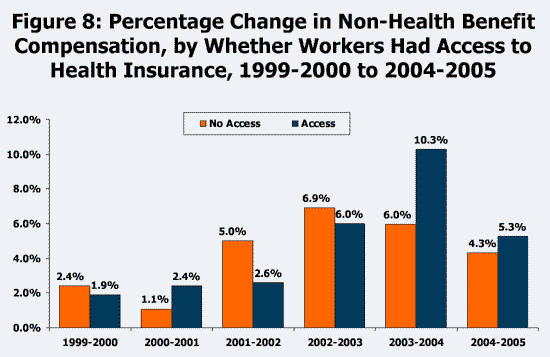
Note: Numbers not adjusted for inflation.
Source: Kaiser Family Foundation calculations based on data from the National Compensation Survey, 1999-2005, conducted by the Bureau of Labor Statistics.
Discussion
We show a substantial gap in compensation between workers with and without health benefit access from the establishments where they work. Workers with access to employer health benefits receive much higher total compensation, payroll compensation, and non-health benefit compensation. The substantial gaps in payroll compensation generally hold up when the data is divided by establishment size and worker occupation.
This paper offers new insight into the diversity of the workforce and the compensation differences for workers with and without access to health benefits at work. Understanding these differences may assist efforts to design affordable approaches to improving access to coverage for workers who currently are not offered coverage at work. The relatively low payroll compensation of workers not currently offered health benefits suggests that it may be difficult for many of them to fund a meaningful portion of the cost of health benefits out of their current compensation.
When evaluating different approaches for extending coverage, special attention to the financial circumstances of these workers and the establishments in which they work seems warranted. For example, payroll differences are consistent and significant across establishment sizes, so policies aimed at providing special protection to smaller business and their workers, while potentially justified and important, may ignore equally important financial hardships faced by larger employers and their workers. Generally, the low payrolls of workers not offered health benefits suggests that relatively generous financial assistance will be needed if these workers are to gain coverage.
This paper was prepared by Gary Claxton of the Kaiser Family Foundation’s Health Care Marketplace Project and Paul Jacobs who formerly worked in that division.
